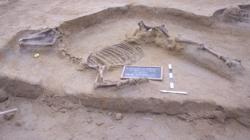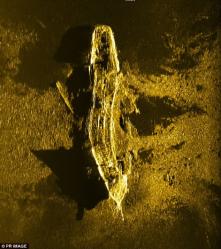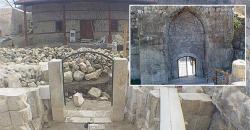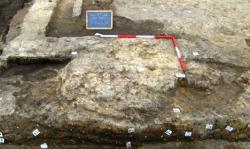INSTITUT SUPERIEUR D'ANTHROPOLOGIE
INSTITUTE OF ANTHROPOLOGY
ONLINE COURSES / COURS A DISTANCE
SPRING TERM : APRIL 2016
REGISTER NOW
GRECE –  Faliro - A burial site containing an unusually well-preserved horse skeleton, intact even down to the hooves, was among the findings discovered during landscaping works around the Stavros Niarchos Foundation Cultural Center at the Faliro Delta, a prime tract of land in southern coastal Athens, Greece, which previously hosted the country’s only pari-mutuel horse track. “In the Faliro necropolis, we have found four complete horse graves, as well as parts of other skeletons, therefore, it is not something rare for the area. What is rare and surprised us was the degree of preservation of the specific skeleton, which even has its hooves. For zoo-archaeologists or a university, this find could be an excellent opportunity for a study. Having such a large number of skeletons – four is quite a number – such a study could reach a number of conclusions on the breeds and the evolution of the species. From this point of view, this discovery is very important,” head archaeologist Stella Chrysoulaki explained. She noted that burying horses in a cemetery for people periodically occurred, while it was not strange for the Faliro necropolis, “where unbelievable things happen.” She noted that it was a cemetery stretching from the Archaic era to the Classical era, containing many strange and unusual findings. One such was the discovery of two skeletons, possibly of a couple, lying with their hands clasped. This indicated that they actually died together, since rigor mortis did not allow other conclusion, she said. A total of 136 burial sites dating back to the Archaic era had been found in the 840-square-meter ancient cemetery, including the horse burial site and sections of a mass grave, burial urns and other findings.
Faliro - A burial site containing an unusually well-preserved horse skeleton, intact even down to the hooves, was among the findings discovered during landscaping works around the Stavros Niarchos Foundation Cultural Center at the Faliro Delta, a prime tract of land in southern coastal Athens, Greece, which previously hosted the country’s only pari-mutuel horse track. “In the Faliro necropolis, we have found four complete horse graves, as well as parts of other skeletons, therefore, it is not something rare for the area. What is rare and surprised us was the degree of preservation of the specific skeleton, which even has its hooves. For zoo-archaeologists or a university, this find could be an excellent opportunity for a study. Having such a large number of skeletons – four is quite a number – such a study could reach a number of conclusions on the breeds and the evolution of the species. From this point of view, this discovery is very important,” head archaeologist Stella Chrysoulaki explained. She noted that burying horses in a cemetery for people periodically occurred, while it was not strange for the Faliro necropolis, “where unbelievable things happen.” She noted that it was a cemetery stretching from the Archaic era to the Classical era, containing many strange and unusual findings. One such was the discovery of two skeletons, possibly of a couple, lying with their hands clasped. This indicated that they actually died together, since rigor mortis did not allow other conclusion, she said. A total of 136 burial sites dating back to the Archaic era had been found in the 840-square-meter ancient cemetery, including the horse burial site and sections of a mass grave, burial urns and other findings.
http://greece.greekreporter.com/2016/01/14/intact-horse-skeleton-discovered-in-ancient-greek-cemetery/?#sthash.o4quh2Ff.dpuf
OCEAN INDIEN –  - Archaeologists believe a shipwreck found in the search for MH370 wreckage may have been a Peruvian-built transport ship that disappeared on its way to Sydney more than 100 years ago. A sonar search for the Malaysia Airlines Flight that vanished almost two years ago uncovered the shipwreck deep in the Indian Ocean. Experts have now claimed that the underwater drone images of the wreck, found 2,600km southwest of Fremantle, Western Australia, may show all that remains of the S.V. Inca. The barque-style 950 GRT (gross register tonnage) ship set sail from Callao, west of Lima, on 10 March 1911 and has not been seen since. We have searched the Australian National Shipwreck Database and believe that it could be S.V. Inca,' Danielle Wilkinson from Cosmos Archaeology said. 'It may fit the parameters of the shipwreck identified in the survey imagery, but it cannot be assessed for accuracy without further research.
- Archaeologists believe a shipwreck found in the search for MH370 wreckage may have been a Peruvian-built transport ship that disappeared on its way to Sydney more than 100 years ago. A sonar search for the Malaysia Airlines Flight that vanished almost two years ago uncovered the shipwreck deep in the Indian Ocean. Experts have now claimed that the underwater drone images of the wreck, found 2,600km southwest of Fremantle, Western Australia, may show all that remains of the S.V. Inca. The barque-style 950 GRT (gross register tonnage) ship set sail from Callao, west of Lima, on 10 March 1911 and has not been seen since. We have searched the Australian National Shipwreck Database and believe that it could be S.V. Inca,' Danielle Wilkinson from Cosmos Archaeology said. 'It may fit the parameters of the shipwreck identified in the survey imagery, but it cannot be assessed for accuracy without further research.
http://www.dailymail.co.uk/news/article-3398722/Shipwreck-mistaken-MH370-wreckage-believed-Peruvian-built-ship.html
TURQUIE –  Korkuteli - During the restoration of the 800-year-old Alaaddin Mosque in the southern province of Antalya’s Korkuteli district, the structure’s crown gate, a rare example of stone masonry, has been broken into pieces. It was claimed the crown gate was enumerated and dismantled as its structure was weak, according to an architect involved in the project, but the scene at the restoration area appeared otherwise, with stone pieces of the gate apparently scattered around the area. Recently, a source revealed the crown gate of the historic mosque was gone. At the site in Korkuteli, it was seen there were no guards or workers present at the historic building, as well as stones thought to belong to the mosque scattered around the area. Some of the stones were numbered while others were not, and there had been no apparent measures taken to protect them.
Korkuteli - During the restoration of the 800-year-old Alaaddin Mosque in the southern province of Antalya’s Korkuteli district, the structure’s crown gate, a rare example of stone masonry, has been broken into pieces. It was claimed the crown gate was enumerated and dismantled as its structure was weak, according to an architect involved in the project, but the scene at the restoration area appeared otherwise, with stone pieces of the gate apparently scattered around the area. Recently, a source revealed the crown gate of the historic mosque was gone. At the site in Korkuteli, it was seen there were no guards or workers present at the historic building, as well as stones thought to belong to the mosque scattered around the area. Some of the stones were numbered while others were not, and there had been no apparent measures taken to protect them.
http://www.hurriyetdailynews.com/gate-of-historic-mosque-causes-restoration-scandal-in-antalya.aspx?pageID=238&nID=93863&NewsCatID=375
ROYAUME UNI –  Moray - A researcher at the University of the Highlands and Islands (UHI) hopes to gain an understanding of sounds heard thousands of years ago. Michelle Walker's investigation will involve a cave in Moray where human remains from the Late Bronze Age were previously found by archaeologists. It is believed prehistoric people buried their dead in the cave in rituals involving beating a drum. Ms Walker has proposed beating a drum in the same location. The UHI graduate believes the acoustics of Sculptors Cave where the bodies were laid could have affected mourners' mood. The research, known as archaeoacoustics, has previously given archaeologists a better understanding of how sound behaves inside Neolithic temples in England and Ireland.
Moray - A researcher at the University of the Highlands and Islands (UHI) hopes to gain an understanding of sounds heard thousands of years ago. Michelle Walker's investigation will involve a cave in Moray where human remains from the Late Bronze Age were previously found by archaeologists. It is believed prehistoric people buried their dead in the cave in rituals involving beating a drum. Ms Walker has proposed beating a drum in the same location. The UHI graduate believes the acoustics of Sculptors Cave where the bodies were laid could have affected mourners' mood. The research, known as archaeoacoustics, has previously given archaeologists a better understanding of how sound behaves inside Neolithic temples in England and Ireland.
ITALIE –  Aquileia - The Roman city of Aquileia, in Friuli Venezia Giulia, is one of Italy's 51 world heritage sites but the discovery of a Bronze Age village just outside the city has cast new light on the area's human history,Corriere della Sera reported. The village was found next to an ancient Roman canal, known as the Canale Anfora, by a team of archaeologists from the University of Udine. From 200BC until 400AD Aquileia – today home to just 3,500 inhabitants – was one of the biggest and most important market towns in Europe, with a population of some 100,000. Much is known about the town's Roman origins, which now stretch back even further. Archaeologists were first alerted to the possible existence of an earlier "protosettlement" after carrying out a geophysical scan in 1980, but had to wait until 2013 before excavations could get underway. The excavations, which concluded in December, have revealed the remains of a Bronze Age village which had area of 100,000 square metres. Among the findings were the foundations of several buildings made from gravel and stone - once the walls of Bronze Age homes. The digs also unearthed a series of open hearths, which were used for cooking and manufacturing goods. Numerous fragments of pottery and other household items such as rudimentary spindles we also found. Based on the artefacts found at the site, experts say the settlement existed for some 300 years between 1500BC and 1200BC, during which time it is thought to have been a key trading point - much like the later Roman town on Aquileia – which followed it. “We think that during the middle Bronze Age the villagers got together with other groups from nearby settlements on convivial occasions, when trade would take place,” Borgna said. The discovery represents another tantalizing challenge for archaeologists in the region, who have until now only excavated a fraction of the ancient Aquileia. Research has now moved out of the field and into the laboratories at the University of Udine, where fragments of organic matter found at the site are being analyzed to try to discover how the villagers ate. The numerous samples of pottery are also being analyzed and accurately dated in a bid to reveal more information about the cultural exchanges which were taking place, 1,000 years before the Roman colony was founded.
Aquileia - The Roman city of Aquileia, in Friuli Venezia Giulia, is one of Italy's 51 world heritage sites but the discovery of a Bronze Age village just outside the city has cast new light on the area's human history,Corriere della Sera reported. The village was found next to an ancient Roman canal, known as the Canale Anfora, by a team of archaeologists from the University of Udine. From 200BC until 400AD Aquileia – today home to just 3,500 inhabitants – was one of the biggest and most important market towns in Europe, with a population of some 100,000. Much is known about the town's Roman origins, which now stretch back even further. Archaeologists were first alerted to the possible existence of an earlier "protosettlement" after carrying out a geophysical scan in 1980, but had to wait until 2013 before excavations could get underway. The excavations, which concluded in December, have revealed the remains of a Bronze Age village which had area of 100,000 square metres. Among the findings were the foundations of several buildings made from gravel and stone - once the walls of Bronze Age homes. The digs also unearthed a series of open hearths, which were used for cooking and manufacturing goods. Numerous fragments of pottery and other household items such as rudimentary spindles we also found. Based on the artefacts found at the site, experts say the settlement existed for some 300 years between 1500BC and 1200BC, during which time it is thought to have been a key trading point - much like the later Roman town on Aquileia – which followed it. “We think that during the middle Bronze Age the villagers got together with other groups from nearby settlements on convivial occasions, when trade would take place,” Borgna said. The discovery represents another tantalizing challenge for archaeologists in the region, who have until now only excavated a fraction of the ancient Aquileia. Research has now moved out of the field and into the laboratories at the University of Udine, where fragments of organic matter found at the site are being analyzed to try to discover how the villagers ate. The numerous samples of pottery are also being analyzed and accurately dated in a bid to reveal more information about the cultural exchanges which were taking place, 1,000 years before the Roman colony was founded.
http://www.thelocal.it/20160113/bronze-age-village-found-near-ancient-roman-city?